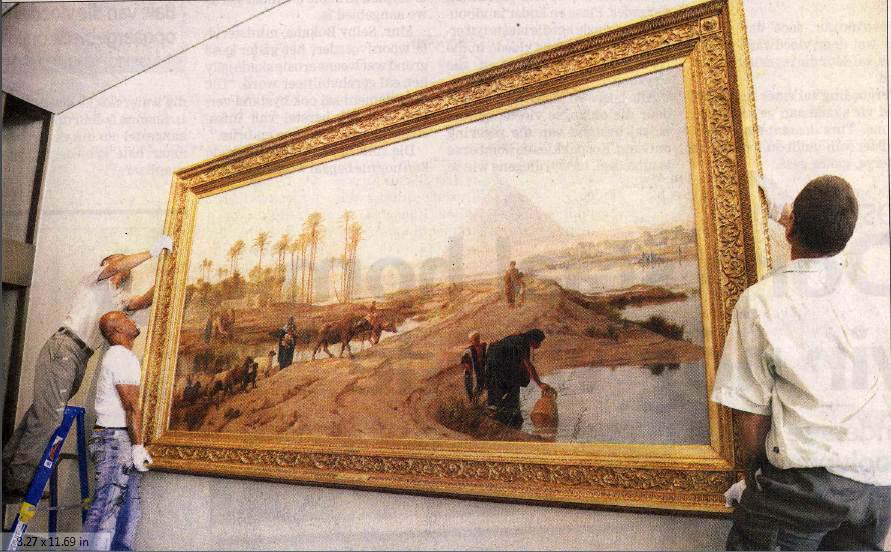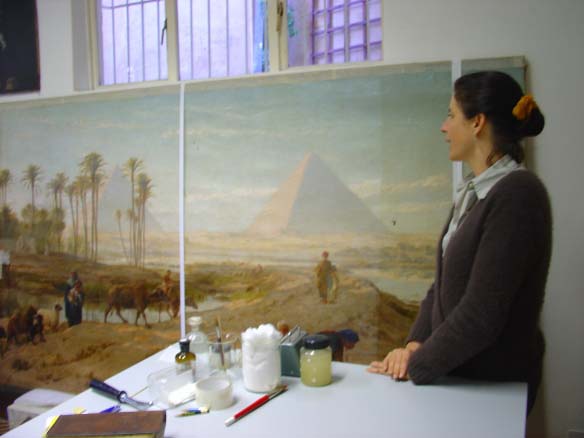The Subsiding of the Nile shows the Giza Plateau from the
south-east, with the Great Pyramid of Khufu on the right, and the Pyramid of
Khafra on the left behind the palm trees with the Sphinx just visible in the
centre. The sheep in the foreground were painted from the flock the
artist bought in Egypt and sent to England to be used as models for this
picture. This was the largest picture painted by Frederick Goodall – it is
approximately 4 metres long and 2 metres high.
Painted in 1872 by Frederick Goodall, this picture was exhibited at
the Royal Academy, London (No. 292) in 1873 and purchased by art dealer Ernest
Gambart for 1200 Guineas – a good sum in those days. Later it was sold to Sir
William Agnew and in 1903 it appears it belonged to a Mr. Orr of Glasgow. An
unconfirmed report suggests the painting was bought in Cairo in 1912 by a Mr.
E.D. Anderson (see below).
This painting used to hang on the first floor of the Cape Town City
Hall. Due to the size and weight of the painting and frame, wall brackets
supported the frame at the base causing the picture to hang forward at an
angle. In turn this caused the canvas to stretch downward and drag away
from the ornate gilded frame which is thought to be the original frame.
In response to my appeal and using the platform of The Egyptian Society of
South Africa, the picture was removed from the unfavourable position in the
Cape Town City Hall and loaned to the South African Cultural History Museum
(now Iziko Slave Lodge) in 1997. Unfortunately, due to changes in the
directorship of the museum and other reasons, the picture remained crated
for 6 years in a store-room at the museum in Adderley Street. In 2003 the
picture was returned to the Cape Town City Council and placed in a store
room where it awaited a decision on its future.
The picture belongs to the people of the Cape Town. However, the date and
manner of acquisition in Cape Town is a mystery and is entirely unknown.
According to unsupported information from a former council employee who died
some year ago, in 1968 T.J. & E.D. Anderson claimed it was on loan to the
City but a court rejected the claim as there was no proof of ownership.
Until now, it has not been possible to locate the court records. It has also
been claimed that an untraceable newspaper report in 1968 stated the picture
had been in the City Hall for at least 40 years.
When I approached the Royal Academy in London for information about
the picture they were unaware that the original painting was in Cape Town
having assumed the small version in the London Guildhall Art Gallery was the
original. Their records have been amended. Frederick Goodall made his
second and last visit to Egypt in 1870-71, accompanied by his brother Edward.
Basing himself at Saqqara in the house of the distinguished archaeologist and
founder of the Egyptian Museum Auguste Mariette-Bey. He spent several months
sketching places and people to be used as the raw material for future
paintings. In 1872 he began using some of his preparatory sketches and the
result was The Subsiding of the Nile exhibited at the Royal Academy
in 1873. There is a reduced version of The Subsiding of the Nile
(76 x 152 cm) exhibited in the City of London’s Guildhall Art Gallery (No.
63). This smaller painting, a quarter of the size of the Cape Town picture,
is signed with the monogram FG and dated 1873. When
Frederick Goodall died in 1904 there were examples of his works in many
provincial art galleries in addition to the Tate Gallery and the Victoria and
Albert Museum in London. Another small copy of The Subsiding of the Nile
has been identified in Bournenouth, UK. Frederick Goodall is buried at
Highgate Cemetery in London along with family members.
With the valued co-operation of Alderman Owen Kinahan, the Cape Town
City Council placed the picture in the capable hands of renowned art restorer
Angela Zehnder in 2007 who was commissioned to clean and restore the
damaged painting. Finally, in February 2011, the restoration of the painting
and the frame was completed and with great anticpation the painting was at
last hung for public viewing in the foyer of the Artscape Opera House, Cape
Town. Newspaper pictures showed the painting in all its glory in the process
of being hung. Fate yet again intervened in the story of this painting –
within 24 hours inexplicably the painting fell off the wall and sustained
serious damage. This very valuable painting was swiftly removed from the
public gaze which had not yet awoken to the fact that the painting
was anywhere to be seen anyway, and it was returned to the tender care of art
restorer Angela Zehnder once more.
Plans to restore the interior of the century-old City Hall include
making provision for the proper display of artworks consistent with civic
government in Cape Town in the period 1900 to 1970. It is hoped this valuable
painting will find its proper home in the City Hall one of these days.
I will write more when restoration is again complete and the
saga of this mysterious painting continues.
Keith Grenville – 09 March 2011
A recent newspaper photo.

Return to
previous page.

